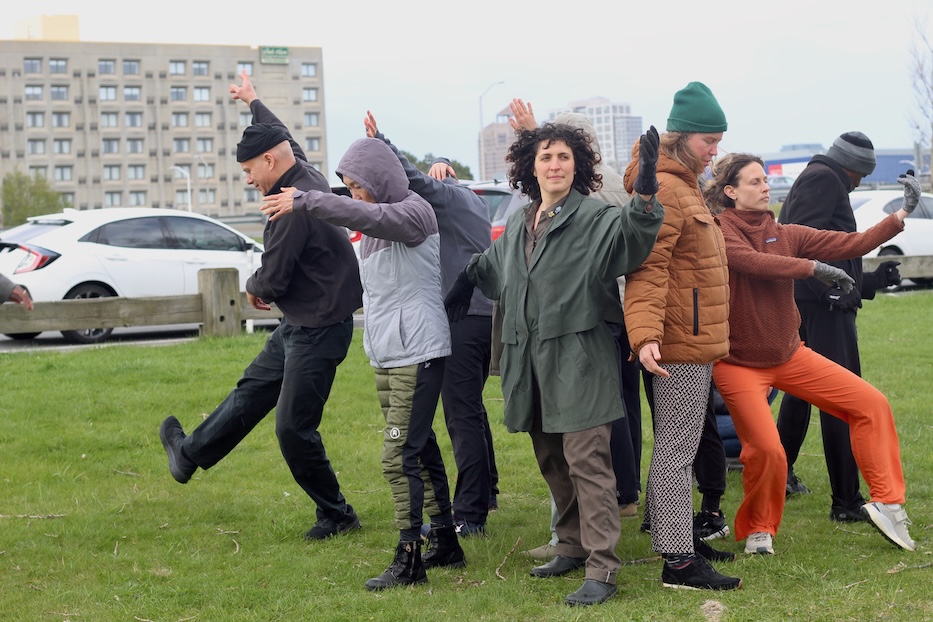
Dance | Elm City Dance Collective | Long Wharf | Arts & Culture | National Water Dance
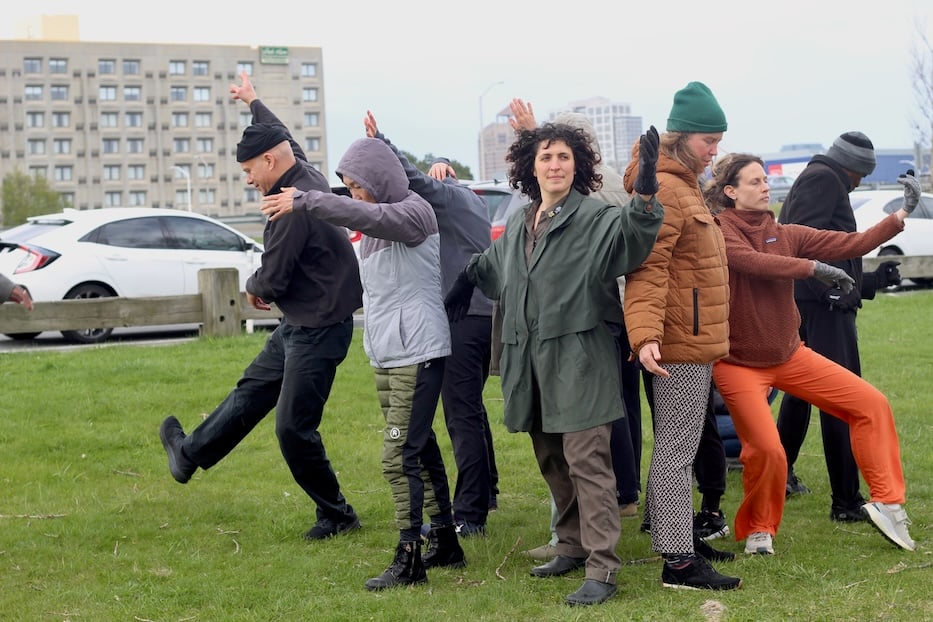
Lucy Gellman Photos.
The dancers stood in a knot of skin and fabric, their coats bright against the gray sky. Around them, a row of taco trucks purred. Seagulls circled and swooped, screaming their hello. Waves rolled into the shore nearby, sending the smell of salt and seaweed into the air. Dancers began to move, legs and arms emerging one by one, and it felt as though a statue had come suddenly to life.
So unfolded a rehearsal for the 2024 National Water Dance, a nationwide dance initiative that the Elm City Dance Collective (ECDC) has taken part in each April since 2018. Performed in towns and cities across the U.S.—in 2022, the count was 65 and growing—the dance is scheduled at Long Wharf Park for 4 p.m. on April 20, with a park cleanup beforehand. This marks the second time the group has performed there: the first was in 2022.
“I wanted to come back because I wanted to learn more about this place,” said ECDC co-founder and artistic director Kellie Ann Lynch a rehearsal on Sunday. “It wasn’t a park that I visited super often before. Now, it’s starting to feel sacred to me.”
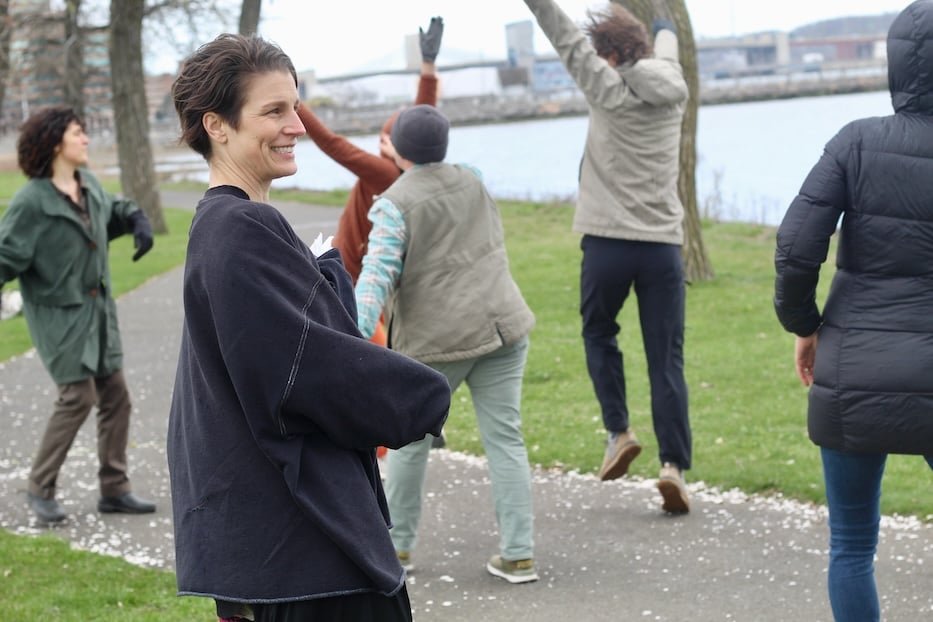
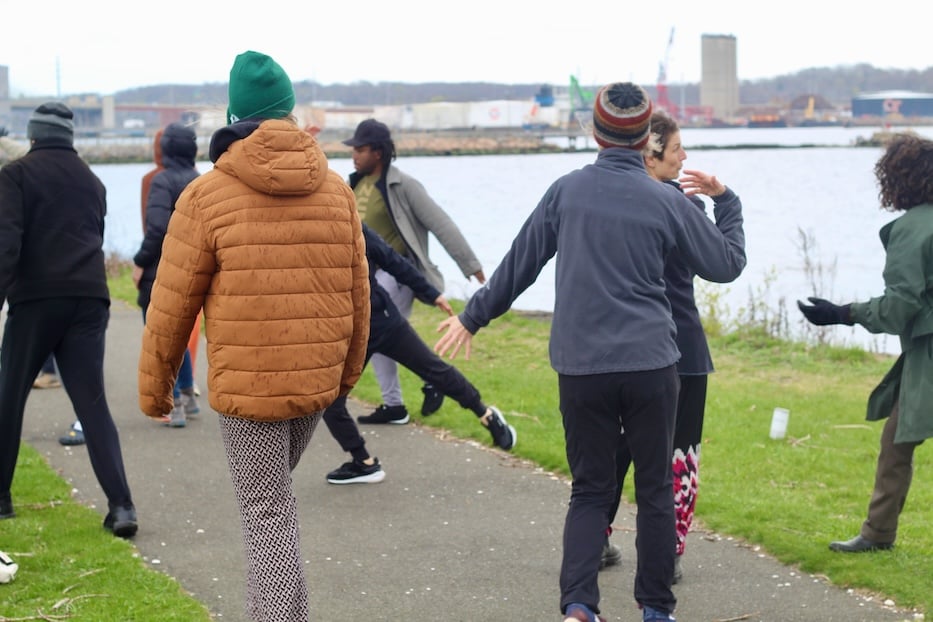
Top: ECDC Co-Founder and Artistic Director Kellie Ann Lynch.
Founded in 2014 as an extension of the Florida Waterways Dance Project, the National Water Dance seeks to use movement to bring attention to water and water conservation, increasingly precious and endangered as the planet warms. The project sits at the intersection of artistry and social justice: dancers may reflect on a sinking Miami, for instance, or a town changed by drought or unprecedented flooding, or the still-visible scars of a hurricane.
Since its inception, dancers have used it as a way to engage with the world and the waterways around them, from Key Biscane to the Long Island Sound to Mayagüez, Puerto Rico. In New Haven, the work has flowed from Lighthouse Point Park to the Mill River to Long Wharf, organizers learning about each spot along the way (read about previous iterations here, here, and here).
Lynch, with ECDC-based collaborators Lindsey Bauer and nikki lee, said she was drawn back to Long Wharf for its deep and layered history. Through both performing and caring for the space, members of the collective have learned about William Lanson, the free Black engineer who built the city’s Long Wharf. They revisited the story of the Amistad rebellion. They studied the strange juncture of taco trucks, highway, and the Long Island Sound—and then became a temporary part of it.
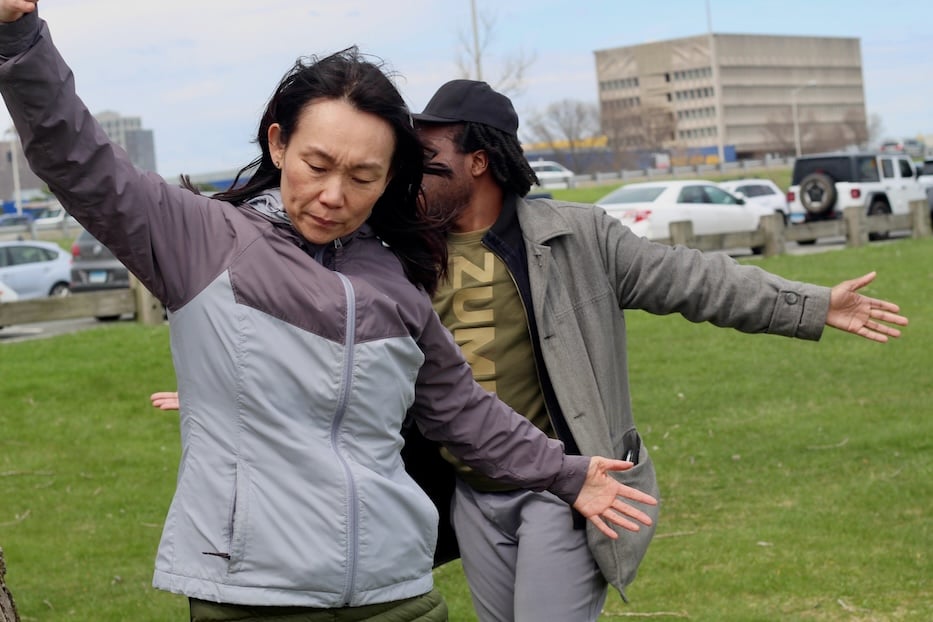
As it returns to New Haven, the dance consists of several different “scores,” each of them based around questions the dancers have been asking each other and themselves. They include, for instance: What would you do if water became dangerously scarce? Unsafe to drink? Not yours? What would it look like if you dried up?
How do you tend to the collective? How do you tend to yourself? If we are made up of mostly water, who owns the water inside of you?
In asking those questions, “we’ve come up with rituals,” Lynch said as dancers’ limbs windmilled around her and a light rain began to fall. One is a weekly trash pick up, which has laid bare the amount of waste—nip bottles, plastic bags and cutlery, bits of styrofoam and foil—that makes it into the Long Island Sound on any given day. Another is a mindfulness practice, asking dancers how often they go to the tap, take a sip or drink of water, or run the sink, bath, or shower.
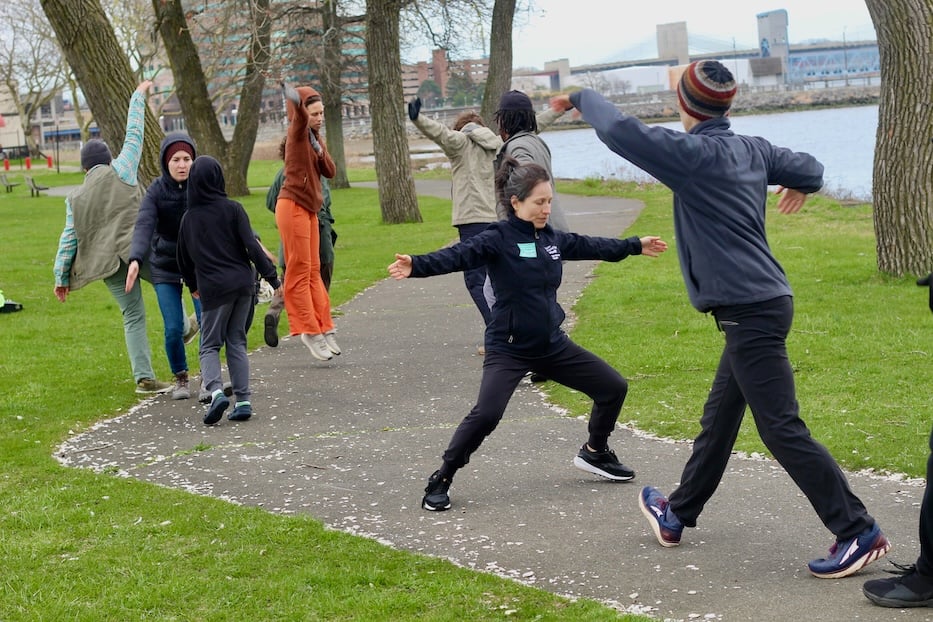
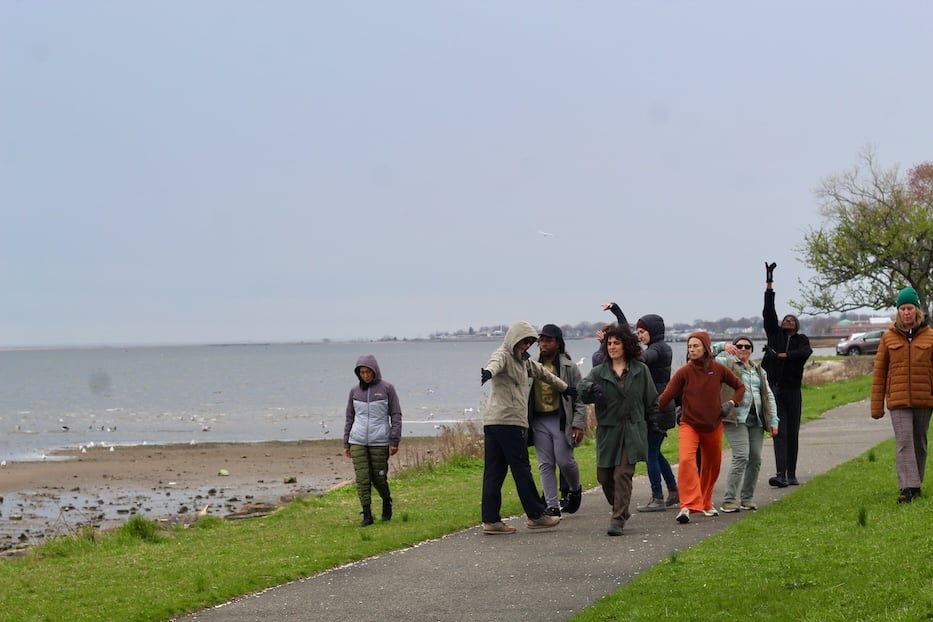
Lynch said that dancers have also turned their thoughts toward Gaza, where the Israeli government is using starvation and lack of humanitarian aid as a weapon of war. Indeed, many of the dancers have been moved by the question What would you do if water became dangerously scarce?, reminded of the miracle and privilege of water simply running, uncoaxed, from the tap.
At a rehearsal Sunday, dancers huddled around a tree, its thick brown trunk rising above their shoulders. On one side of the group, blue-gray water stretched out, interrupted by oil drums and the winding, raised concrete and asphalt of I-95. On the other, families sidled up to food trucks with their orders of elotes, agua fresca, and tacos of at least six different varieties. Some stopped on benches and made their way through the park, snippets of conversation audible as they passed.
From the center of the group, nikki lee lifted a pitcher of water, and began to walk around the circle, stopping at each dancer. In their hands, the container looked delicate, as if they did not want to waste a single drop. When members began to stir, limbs rising slowly into the air, it was almost as if they had been holding their breath, waiting for that precious first sip to release it.
Around them, the park became the soundtrack. A constant hum and whirr floated from the nearby taco trucks, the whoosh of the highway just beyond it. Gulls circled and swooped overhead, so shrill they edged on cackling. Waves, low and unbothered, rippled into the sand and rocks. A dirt bike growled and roared as it passed. As dancers shifted, their breath and footfalls joined in, audible if a person listened for it.
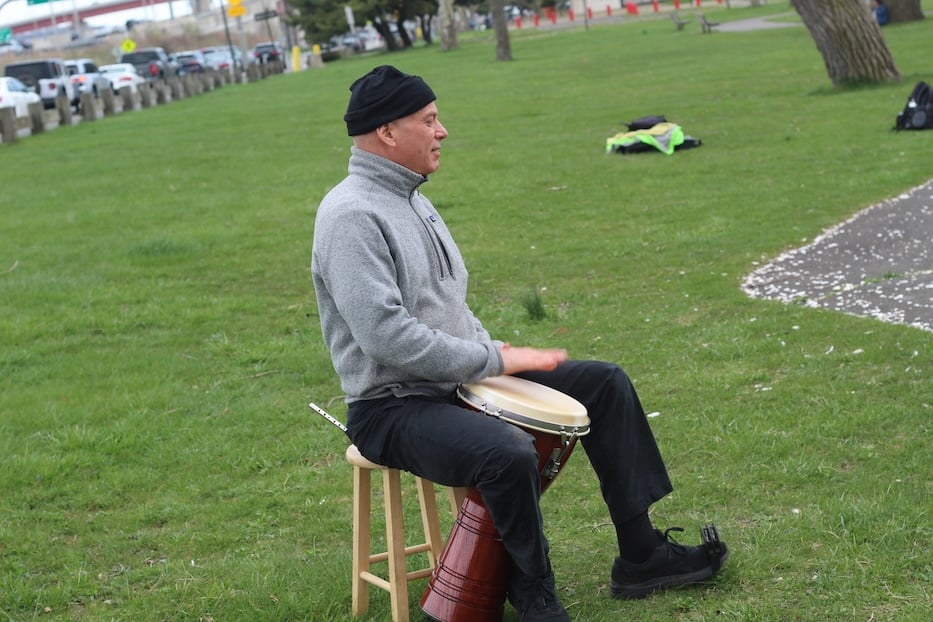
As he walked along the grass, Bob Bergner pulled out a stool and a djembe, and suddenly drumbeats filled the air. Assembled in a single-file line in front of him, dancers burst into movement, their limbs electric. At the back, Julia Byron extended her arms, bending at the knees as she rocked to the left, and then slowly to the right. Closer to the front, Lindsey Bauer crouched and held her young son, whispering something into his ear. In the center, a handful of dancers closed their eyes and improvised, their limbs suddenly soft and fluid.
As he bent back toward the grass, arms outstretched and wing-like, dancer Wes Yarbor said he was grateful for the chance to participate. A longtime New Havener and alum of the Alvin Ailey American Dance Theater, Yarbor is accustomed to trying new things in his practice, he said. And yet, the National Water Dance surprised and delighted him when he joined ECDC for the first time in 2022.
For him, he said, it’s about the spirit of community and conservation that the dance embodies. On one hand, the Water Dance is solitary—it’s about his relationship with place and water, the way his body moves to honor it. On the other, it’s an event that does not exist without its collective spirit. He loves that his colleagues in both New Haven and New York City will be moving to the sound of nature at the same time, making the ritual their own.
“I can connect with them through this,” he said. “Sometimes, you gotta put yourself out there. It’s a completely different way to come outside of yourself.”
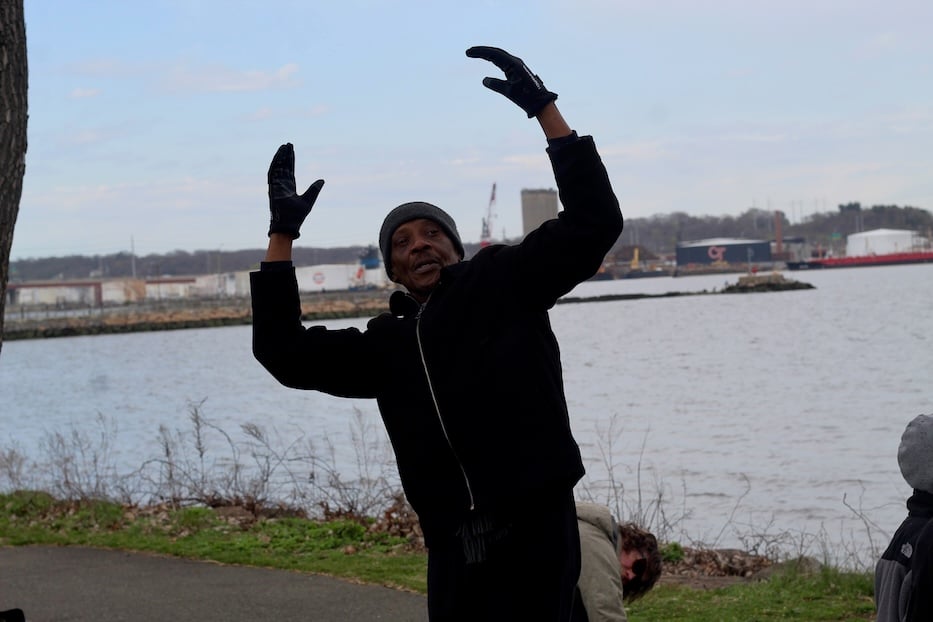
Wes Yarbor: "It’s a completely different way to come outside of yourself."
And it is. This year, both the dance and its location feel urgent, as temperatures continue to rise and plastic waste fills waterways worldwide, disrupting both patterns of consumption and aquatic and human life. Microplastics are now everywhere: in drinking water, in the food we cook and eat, in the animal products we consume—even in human placentas and breast milk.
As the planet warms, meanwhile, access to safe and clean drinking water is deeply endangered. Over two billion people don’t have access to clean drinking water, according to a 2022 report by the United Nations. Meanwhile, only three percent of the earth’s total water—including glaciers that are rapidly melting—is fresh.
As sea levels rise, cities are also sinking, displacing millions of people per year. Particularly in nations more vulnerable to climate change, drought, famine, and extreme weather events are all becoming more common.
New Haven isn’t immune to any of that. Climate change and sea rise has meant wetter winters and unprecedented levels of flooding. Locally, Save The Sound has pointed to both industrial runoff and litter on streets and sidewalks—particularly cigarette butts, and the proliferation of plastic nip bottles—as a threat to Connecticut waterways and the plants, people and animals that rely on them.

For Adira Cox and Breanna Dawson, both seniors at Cooperative Arts & Humanities High School, the Water Dance was an entry point into those discussions. For weeks, they’ve been coming to park clean-ups with Bauer, who is one of their dance teachers at school.
Both have found that they’re now more conscious of the world around them, from New Haven’s ponds and greenspaces to the trash that they see on the street.
“I’d never really thought about having a relationship with the water,” Dawson said. “Now, I think about litter a lot. Especially because kids should be able to have a safe area to play.”
“It’s different,” Cox added of the dance itself, which has introduced her to a new, more fluid kind of way of moving her body. “I personally think that dance can tell a story—like, you’re telling a story with your body.”

